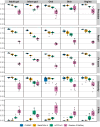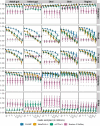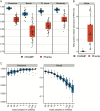CHAMP delivers accurate taxonomic profiles of the prokaryotes, eukaryotes, and bacteriophages in the human microbiome
- PMID: 39483755
- PMCID: PMC11524946
- DOI: 10.3389/fmicb.2024.1425489
CHAMP delivers accurate taxonomic profiles of the prokaryotes, eukaryotes, and bacteriophages in the human microbiome
Abstract
Introduction: Accurate taxonomic profiling of the human microbiome composition is crucial for linking microbial species to health outcomes. Therefore, we created the Clinical Microbiomics Human Microbiome Profiler (CHAMP), a comprehensive tool designed for the profiling of prokaryotes, eukaryotes, and viruses across all body sites.
Methods: CHAMP uses a reference database derived from 30,382 human microbiome samples, covering 6,567 prokaryotic and 244 eukaryotic species, as well as 64,003 viruses. We benchmarked CHAMP against established profiling tools (MetaPhlAn 4, Bracken 2, mOTUs 3, and Phanta) using a diverse set of in silico metagenomes and DNA mock communities.
Results: CHAMP demonstrated unparalleled species recall, F1 score, and significantly reduced false positives compared to all other tools benchmarked. The false positive relative abundance (FPRA) for CHAMP was, on average, 50-fold lower than the second-best performing profiler. CHAMP also proved to be more robust than other tools at low sequencing depths, highlighting its application for low biomass samples.
Discussion: Taken together, this establishes CHAMP as a best-in-class human microbiome profiler of prokaryotes, eukaryotes, and viruses in diverse and complex communities across low and high biomass samples. CHAMP profiling is offered as a service by Clinical Microbiomics A/S and is available for a fee at https://cosmosidhub.com.
Keywords: MAG; bacteriophages; benchmarking; human microbiome; metagenomics; taxonomic profiling.
Copyright © 2024 Pita, Myers, Johansen, Russel, Nielsen, Eklund and Nielsen.
Conflict of interest statement
All authors are current or previous employees and/or shareholders of Clinical Microbiomics A/S, a contract research organization offering CHAMP profiling as a service.
Figures




Similar articles
-
Cultivation-independent genomes greatly expand taxonomic-profiling capabilities of mOTUs across various environments.Microbiome. 2022 Dec 5;10(1):212. doi: 10.1186/s40168-022-01410-z. Microbiome. 2022. PMID: 36464731 Free PMC article.
-
Crowdsourced benchmarking of taxonomic metagenome profilers: lessons learned from the sbv IMPROVER Microbiomics challenge.BMC Genomics. 2022 Aug 30;23(1):624. doi: 10.1186/s12864-022-08803-2. BMC Genomics. 2022. PMID: 36042406 Free PMC article.
-
Evaluation of the Microba Community Profiler for Taxonomic Profiling of Metagenomic Datasets From the Human Gut Microbiome.Front Microbiol. 2021 Apr 20;12:643682. doi: 10.3389/fmicb.2021.643682. eCollection 2021. Front Microbiol. 2021. PMID: 33959106 Free PMC article.
-
An in-depth evaluation of metagenomic classifiers for soil microbiomes.Environ Microbiome. 2024 Mar 28;19(1):19. doi: 10.1186/s40793-024-00561-w. Environ Microbiome. 2024. PMID: 38549112 Free PMC article.
-
Experimental metagenomics and ribosomal profiling of the human skin microbiome.Exp Dermatol. 2017 Mar;26(3):211-219. doi: 10.1111/exd.13210. Epub 2017 Jan 20. Exp Dermatol. 2017. PMID: 27623553 Review.
Cited by
-
Partially hydrolyzed, whey-based infant formula with six human milk oligosaccharides, B. infantis LMG11588, and B. lactis CNCM I-3446 is safe, well tolerated, and improves gut health: a staged analysis of a randomized trial.Front Nutr. 2025 Jul 23;12:1628847. doi: 10.3389/fnut.2025.1628847. eCollection 2025. Front Nutr. 2025. PMID: 40771223 Free PMC article.
-
Microbiome composition and metabolic pathways in shallow and deep periodontal pockets.Sci Rep. 2025 Apr 15;15(1):12926. doi: 10.1038/s41598-025-97531-0. Sci Rep. 2025. PMID: 40234709 Free PMC article.
-
Sequence modeling tools to decode the biosynthetic diversity of the human microbiome.mSystems. 2025 Jul 22;10(7):e0033325. doi: 10.1128/msystems.00333-25. Epub 2025 Jun 30. mSystems. 2025. PMID: 40586419 Free PMC article. Review.
-
The association between the gut microbiome and 24-h blood pressure measurements in the SCAPIS study.Commun Med (Lond). 2025 Jul 7;5(1):276. doi: 10.1038/s43856-025-00980-x. Commun Med (Lond). 2025. PMID: 40624247 Free PMC article.
References
LinkOut - more resources
Full Text Sources
Research Materials

